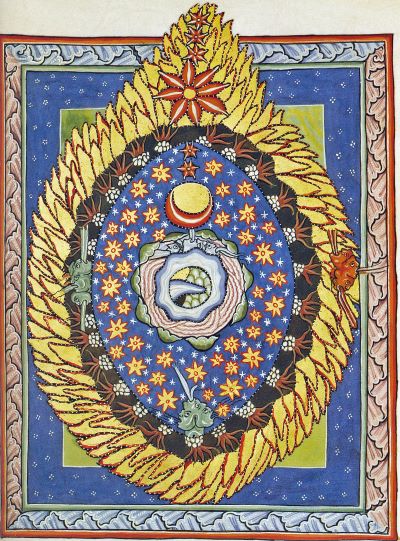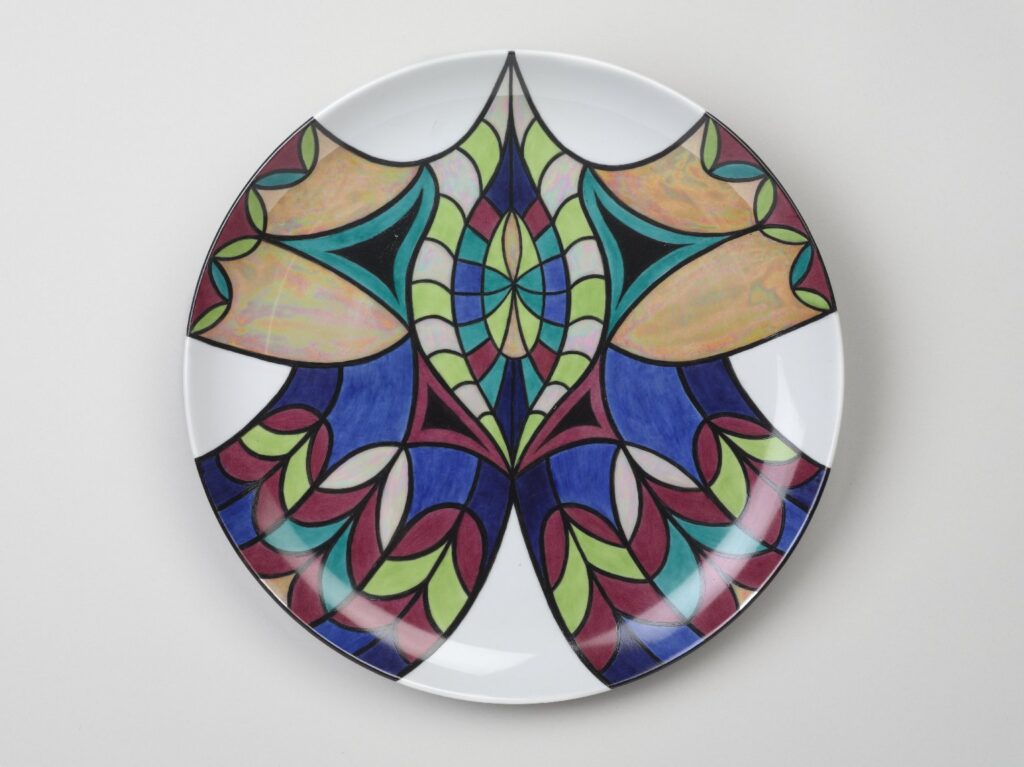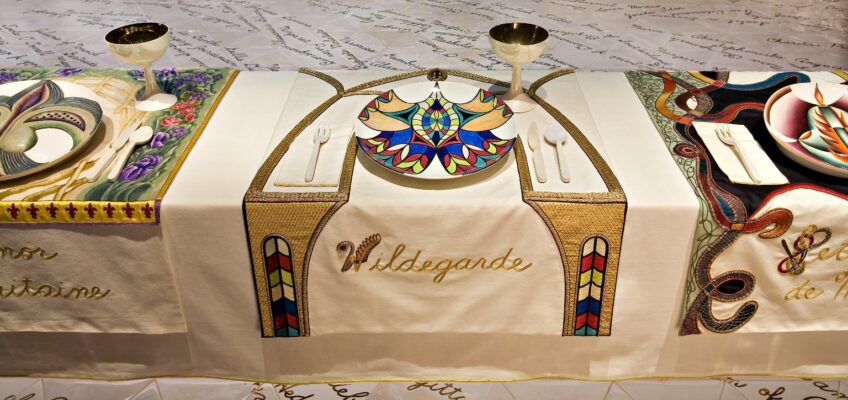Judy Chicago: Hildegarde of Bingen Place Setting
Judy Chicago and The Dinner Party
Judy Chicago’s iconic installation artwork, ‘The Dinner Party‘ was presented at UCLA Armand Hammer Museum and Cultural Center, Los Angeles. I had the profound opportunity to attend and witness this monumental installation artwork.
It first debuted in 1979, set on a triangular table, 48′ x 48′ x 48′, a symbol of the divine feminine. There are 39 elaborate place settings on a triangular table for 39 mythical and historical famous women. 13 women per side. I saw the table as a high altar, holding a sacred and reverential atmosphere. As I entered the dimly lit gallery, the table was bathed in a solitary light, casting an aura of significance and solemnity over the scene. Visitors, including myself, moved through the space in hushed tones, fully aware of the historical and artistic weight of what we were about to witness.
Each place setting features a table runner embroidered with the woman’s name and images or symbols relating to her accomplishments, with a napkin, utensils, a glass or goblet, and a plate. Many of the plates feature a butterfly- or flower-like sculpture representing a vulva.
How did Judy Chicago first encounter Hildegard von Bingen?
I get asked almost the same question of how I first encountered Hildegard von Bingen. It usually after a screening of my film, “The Unruly Mystic: Saint Hildegard.” I have a clear recollection of seeing Hildegard’s Scivias images like Cosmic Egg (below) while reading an art history book as an university student.

So how did Judy Chicago become aware of Hildegarde von Bingen by the mid-1970s? What was her source? Could it be Anaïs Nin? Is that why there is the French spelling of Hildegarde with an “e”?
Judy Chicago writes:
When I was searching for antecedents to my own determination to create an openly female-centered art in the early 1970’s, I was mentored by the diarist Anaïs Nin. At that time, I was researching women’s literature and reading the entire bodies of work by the great 19th and 20th century female authors as well as all of Anaïs’ work, which chronicles her slow, painful journey to emerge from the stifling constraints of the construct of womanhood. At that time, Anaïs and I discussed if there was anything that could be described as a female perspective in the arts. I will never forget her reply that nourished me for decades. She said that women’s psyche was like a light beam that could penetrate to the core of existence, which brought to mind Virginia Woolf’s book, To the Lighthouse.
https://judychicago.com/chicago_gazette/chicago-gazette-14/

Judy Chicago’s Hildegarde represented in the place setting
I found Hildegard’s place setting between Eleanor of Aquitaine (c. 1122 –1 April 1204) and Petronilla de Meath (c. 1300 – 3 November 1324). Hildegarde of Bingen Place Setting is modeled after a rose window, the central stained glass window in any gothic cathedral, often considered the spiritual center of the church. Her plate is painted as a rose window, the central stained glass window in any cathedral, often considered the spiritual center of the church. When viewed from different angles, the iridescent white and yellow hues of the plate transform, playing with light and shadow, and giving the effect of rose glass.
The triangular shape of the table, meticulously set with place settings dedicated to famous women from history, evoked a sense of sacred geometry and precision. Each place setting was a work of art in itself, resonating with symbolism and meaning. The lighting, selectively focused on the table, created an intimate and isolated space, intensifying the experience.
What struck me most was the resemblance of the table to an altar in a Catholic church, where the precision of the settings mirrored the reverence of a religious ceremony. In this moment, I recognized the powerful message of ‘The Dinner Party’—to challenge and reshape the traditional art narrative that often overlooked or marginalized the achievements of women. It was a celebration of women’s contributions to history and culture, presented in a manner that demanded attention and recognition.
This encounter with ‘The Dinner Party’ left an indelible mark on my perspective, sparking a deep interest in women’s roles in history and the arts, and as feminists. It was a transformative experience that would later influence my exploration of figures like Hildegard von Bingen and her enduring legacy. The immersive and visually striking nature of the exhibit revealed the transformative power of art and historical representation, setting the stage for a journey of discovery and connection with remarkable women throughout history.
Another source of inspiration
Nine months after seeing this show, after countless days of excitement, planning, and much anxiety, I would witness the miracle of life, right before my eyes, as a new father.
The journey of parenthood began with an incredible bond that developed between my partner and me during those nine months. We shared every moment of joy, anxiety, and wonder as our baby grew inside her. From the first little flutter of movement that felt like a delicate butterfly dancing in her belly, to the powerful kicks that reminded us of the tiny life growing within, every milestone was etched into our hearts.
The powerful cycles of the female human body, the ability to ovulate, become pregnant, and then give birth to a new human being, left a far greater mark on me than I could have ever imagined. It was a humbling experience, a reminder of the incredible strength and resilience that lies within every woman.
Read More
“The Dinner Party” has been the subject of countless articles and art history texts and is included in innumerable publications in diverse fields. The impact of The Dinner Party was examined in the 1996 exhibition, Sexual Politics: Judy Chicago’s Dinner Party in Feminist Art History. Curated by Dr. Amelia Jones at the UCLA Armand Hammer Museum, this show was accompanied by an extensive catalog published by the University of California Press.
Judy Chicago (born Judith Sylvia Cohen; July 20, 1939) is an American feminist artist, art educator, and writer known for her large collaborative art installation pieces about birth and creation images, which examine the role of women in history and culture.
For more information about Judy Chicago’s work, please visit www.JudyChicago.com and www.throughtheflower.org.


Comment ( 1 )